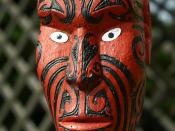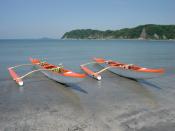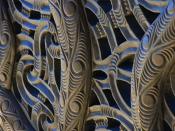Maori are the indigenous people of New Zealand. Although they are described as one large group of people, they are a combination of many different tribes and units. Within these tribes, there are variations of dialects, habits, and rituals. Before contact with the Europeans, the people did not call themselves Maori. This was an adoption from their language, meaning "normal." They used this word to distinguish themselves from the Europeans.
According to the 1996 census, Maori population is well over 500,000, which is about fifteen percent of the population in New Zealand. Of this number, more than ninety-five percent live on the North Island.
Maori oral history has maintained that they arrived from the Polynesian Islands around one thousand years ago in ancestral voyaging canoes. The Maori traditions speak of seven great canoes that brought them from their homeland called Hawaiki. Maori migrations have been dated between 1200 and 1400, but dispute has been raised as to whether the move was planned or an accidental discovery.
In most communities, people hunted, plowed, weeded, wove, and cooked. Pastimes include artistry, poetry: written and oral, tattooing, and carving: wood, bone and stone.
There are many people who have written ethnographies about the Maori. One book is called The Maori War Canoe, by Jeff Evans. It is about the history of these craft, how they were traditionally built, and what the various parts of the canoe signify. One of the key lines from the book is, "A Maori war canoe being paddled at full speed makes an awesome sight." Some other significant ethnographies include authors like: Cleve Barlow, Charles Higham, Ihimaera Witi, and Andrew Sharp.
The population of the Maori suffered soon after introduction to the English. They had succumbed to the evils of alcohol along with the introduction of the musket.


